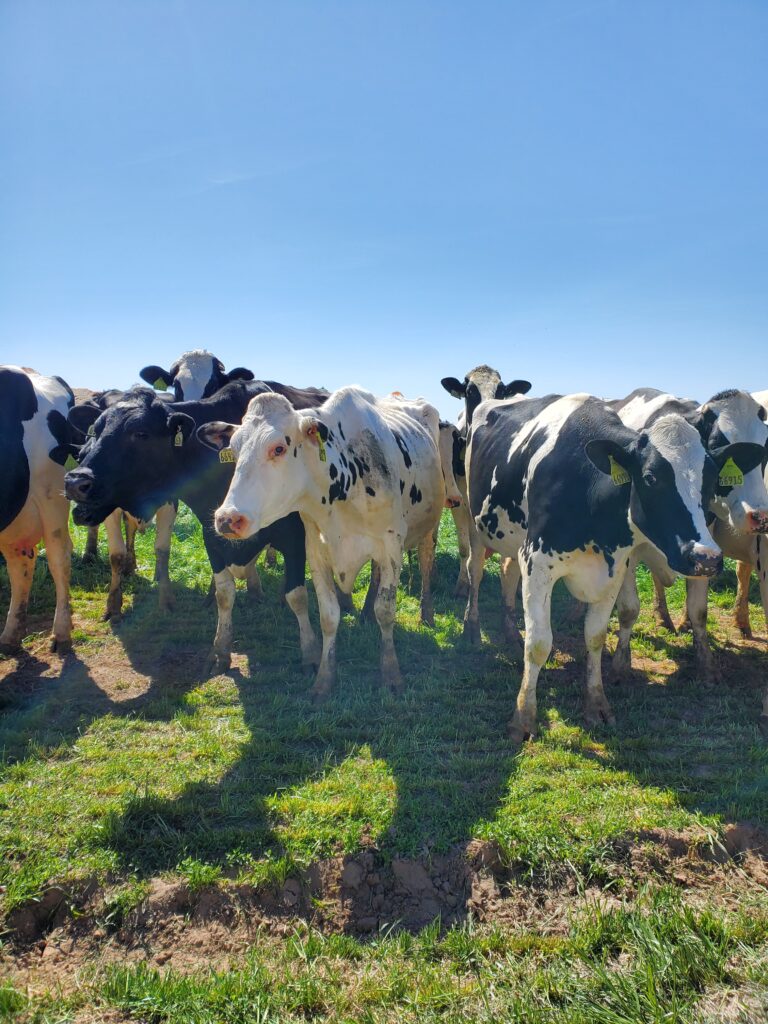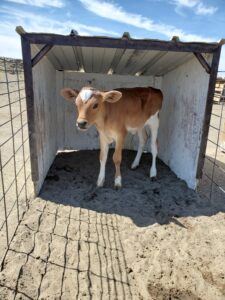This month, we celebrated National Farm Animals’ Day, and we figured, what better way to celebrate it than introducing you to the ladies on the farm. In Nevada, there are two different breeds of dairy cows that stomp the yard: Holstein cows and Jersey cows.
Let’s take a deep dive into the histories of these cows and their characteristics.
Holstein Cows
These ladies are what most people think of when they think of dairy cows because of their beautiful black-and-white spotted pattern. Roughly 2,000 years ago, black cows from the Batavians (now known as Germany) and white cows from the Friesians (known today as Holland) were crossbred to create a new kind of cow: a Holstein! This crossbreeding allowed farmers to produce a hefty amount of milk without needing more resources to do so. Per lactation cycle, the average Holstein produces about 25,000 pounds or around 2,900 gallons of milk.
Holsteins were brought to the United States in 1852 as there was a growing demand for milk and, thus, cattle. The popularity of this breed skyrocketed because their milk had a uniquely delicious taste! Inspiration struck the industry and, soon, many other dairy farms were filled with Holsteins.
Out of the approximate 9 million dairy cows in the United States today, 94 percent of them are Holsteins. Considered the high-performance athletes of the milking world, these cows are present in over 150 countries.
Want some more fun facts about Holstein cows? We got you!
- On average, a mature Holstein weighs roughly 1,500 pounds and reaches a height of around 58 inches at the shoulder.
- When Holsteins are born, they weigh anywhere from 80 to 100 pounds.
- Every Holstein has unique spots—no two cows have the same hide!
Jersey Cows
Ever seen cows with a beautiful brown color and large eyes? Those lovely ladies are known as Jersey cows. They are very curious and tend to cause mischief on the dairy farm. Jersey cows—one of the oldest breeds of this species—originated from the Channel Islands, a destination found between the coast of France and the English Channel. In the 1740s, these cows were brought to England and then, nearly one century later, to the United States.
Jersey cows are great for dairy farming thanks to their exceptional milk production, efficiency, and adaptability. Despite their smaller size compared to other breeds, they produce milk with 18 percent more protein, 20 percent more calcium, and 25 percent more butterfat. These nutrients make their milk more valuable for dairy product production, especially when it comes to cheese and butter. Jersey cows are efficient grazers, meaning their ability to convert feed into milk ensures economical dairy operations. They are also incredibly adaptable to their environments, allowing them to thrive in different climates around the world.
Here are some fun facts about Jersey cows!
- Jersey cows can be identified by their cowhide that’s a lighter shade of brown, their black muzzle, and—should you get this close to one—their white or black tongue.
- A Jersey cow’s switch, the hair at the end of their tail, is black, contrasting the rest of their body.
- Typically, Jersey cows have white markings on their hide mixed into their fawn coloring.
- Jersey cows are smaller breeds, as mature adults they only reach about 1,000 pounds.
- While most cattle only live to be between 18 and 22 years old, Jersey cows tend to live 25+ years.
Cow Care
In Nevada’s dairy farming landscape, the presence of both Holstein and Jersey cows is important to producing quality milk and, in turn, dairy products. These ladies put in their fair share of work on the farm, so it’s only right they’re well taken care of and happy! To make sure the cows on Nevada dairy farms are comfortable, our farmers take the following measures:
- Providing balanced diets: When we’re in good health, it’s easier to live life to the fullest. It’s the same for cows! That’s why we partner with professional animal nutritionists. Together, we develop balanced diets that contain protein, fat, fiber, vitamins, and minerals from feed mixtures that include grasses, alfalfa, cottonseed, corn, and almond hulls. Additionally, cows have access to fresh, clean water 24/7.
- Keeping the cows comfy: When the weather is warmer, cows have misters, shade structures, and large fans that cool them down from the dry heat and scorching sun. They also have large pens that are cleaned 2-3x a day and filled with soft bedding and raked dirt. (Did you know lying in the dirt actually keeps cows cool?)
- Maintaining regular veterinarian check-ups: Routine check-ups help our farmers stay on top of their herd’s health. When cows are feeling a bit under the weather, they are isolated in a separate pen, and their milk is disposed of.
Caring for our cows is also caring for our environment, as cow stress has a direct impact on the herds and their habitat. When the overall welfare of the cows on our dairy farms is good, it runs efficiently, and delicious milk is produced for our communities.
Learn more about cow care on the farm by watching this video!



